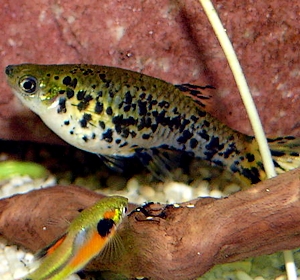
| Species | Spotted Livebearer |
|---|---|
| Other names | Spotted Topminnow |
| Latin Name | Phalloceros Caudimaculatus |
| Family | anabantoids |
| Origin | Ameryka Południowa |
| Length | 3,5 - 6,0 cm |
| Temperature | 18 - 24°C |
| Water Hardness | medium hard - hard |
| pH | 7.0 - 8.0 |
| Aquarium Size | 60 L |
| Food | wszystkożerny |
Spotted livebearer, Spotted topminnow, One-spot livebearer
A freshwater fish that, in natural conditions, inhabits ponds, backwaters, marshy areas, slowly moving streams and brooks in Brazil, Uruguay, Argentina and Paraguay. These habitats are characterized by a low water level and abundant vegetation. The species has been artificially introduced to Australian and African reservoirs to control mosquito populations. Currently, it is considered an invasive species there.
This species is very diverse in terms of colour and pattern. It is characterized by a silver-yellow body colour with a lighter belly. Black spots, which depending on the specific variant, have different shapes, sizes, and ranges, are visible on the body. The fins are yellowish with a delicate bluish margin, and may also be dotted with black spots. In aquaristics, three variants are known: spotted ("reticulatus"), golden ("auratus") and golden spotted ("reticulatus auratus"). The male is almost twice smaller than the female, and also has a gonopodium - a hook-shaped copulatory organ. The female is significantly thicker in the abdominal areas.
This is a calm and active fish, which can be easily kept in a community aquarium. However, it may happen that it nibbles on the fins of other species. The fish is adapted to feed from the water's surface and can nibble on soft and delicate plants. It is a resistant and robust species that can be recommended for beginner aquarists.
The aquarium should contain plenty of plants, including floating ones, but also free spaces for swimming freely, and a gravel substrate. The water flow should be gentle. A small amount of aquarium salt can be added to the water. Regular partial water changes are essential - about 20% every two weeks.
This is a viviparous fish. Fish breed freely in a general aquarium. Given the constant harassment of females by males in the pursuit of copulation, the group of fish should have a majority of females. Fertilization is internal. The gestation period is 3-4 weeks and depends on the water temperature. From one litter, the female gives birth to 10-60 young ones, which are still in their egg membranes. The young ones fall to the bottom and after about an hour they swim freely in search of food. The female is ready for the next reproduction after 5-6 weeks. Parents should not eat fry if they are properly fed.